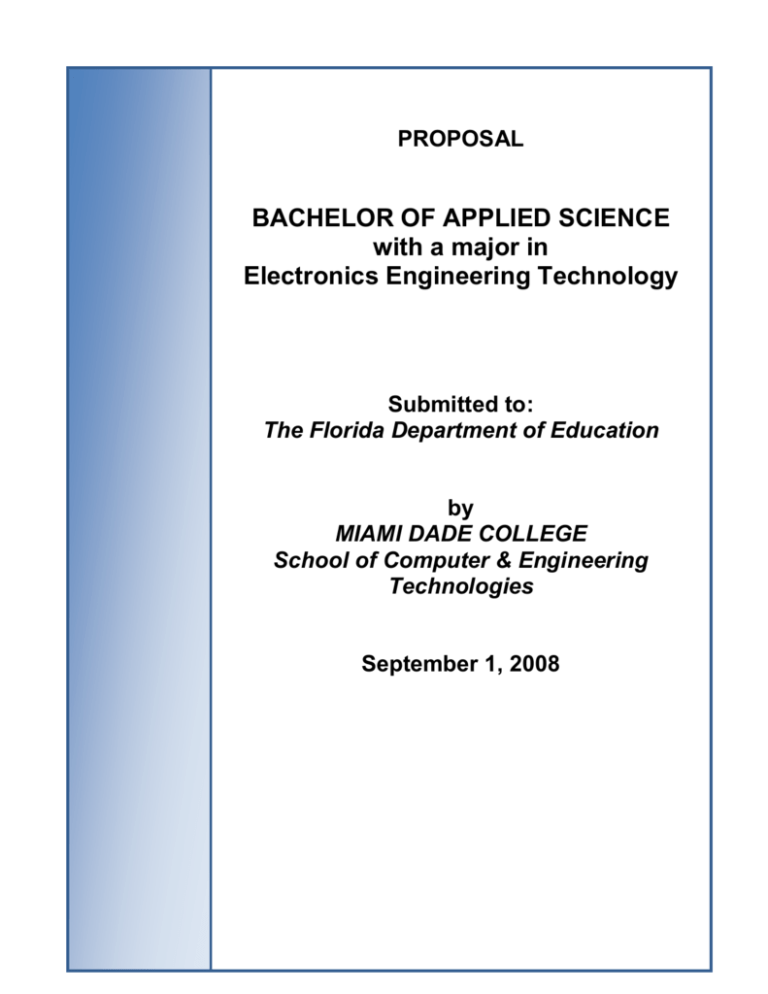Workforce Needs/Demands
advertisement

Applied Science - Supervision and Management - Appendices PROPOSAL BACHELOR OF APPLIED SCIENCE with a major in Electronics Engineering Technology Submitted to: The Florida Department of Education by MIAMI DADE COLLEGE School of Computer & Engineering Technologies September 1, 2008 A. Executive Summary Miami Dade College (MDC) offers an Associate in Science (AS) degree in Electronics Engineering Technology (EET) and is proposing to offer a Bachelor of Applied Science with a major in Electronics Engineering Technology (BAS EET) degree in accordance with Florida Statute Section 1007.33. The objective is to address the local workforce need for baccalaureate-level engineers and to provide a smooth articulation for MDC’s AS graduates to attain a degree at a local institution that will support higher paying careers. On the statewide level, the Department of Labor occupation profile for Electronics Engineers in Florida projects annual growth to be 21% over the 10-year period 2004 to 20141. The Florida Agency for Workforce Innovation, Labor Market Statistics Center projects the annual growth rate for all engineering occupations at 17.04% from 2007 – 2015. Miami Dade College’s Office of Institutional Research conducted surveys between June 2007 and September 2007 among employers, current students, and alumni to gauge the need for and level of interest in a baccalaureate degree in electronics engineering technology within Miami-Dade County. An initial student survey returned a statistical sampling of 153 respondents, comprised of both Associate in Science and Associate in Arts engineering majors. A second survey, conducted to identify the level of interest among Associate in Science engineering majors, yielded a sample of an additional 37 responses for a total survey sample of 190 subjects. The Employer survey was conducted among six companies who jointly employ over 12,000 workers in Region 23. In a sampling of current Associate in Science Electronics Engineering Technology majors (AS EET), 87% (32) who responded said they intend to pursue a baccalaureate degree after completing their associate’s degree (Appendix 1). Note: MDC enrolls an average of 300 AS EET majors per year. Over 78% (25) of the AS EET student sample said they would enroll at Miami Dade College if it offered a bachelor’s degree (Appendix 1). Employers who responded to the MDC Employer Survey projected as many as 200 incumbent workers would be interested in enrolling in a BAS EET if offered at Miami Dade College and local employers project a need to hire over 500 engineers with baccalaureate degrees over the next three to five years (Appendix 2). In responding to MDC’s employer survey (Appendix 2), Florida Power and Light (FPL) indicated that potentially 200 employees would be interested in participating in a BAS EET program if offered at Miami Dade College, noting that it has not been successful in hiring local BS Engineering graduates who are able to pass FPL’s qualification examinations. Miami Dade College, however, has a close partnership with FPL, having recently developed an AS degree in Electrical Power Technology pipeline partnership tailored specifically to FPL’s needs and qualification exams. The proposed MDC BAS EET curriculum was developed with direct industry input from FPL and other local employers, and will provide students with the opportunity to acquire the skills and knowledge required by industry for entry-level electronics engineering positions. In a survey of combined Associate in Science and Associate in Arts engineering majors conducted in September 2007 (Appendix 4), 58.2% (92) of AA/AS engineering majors answered yes when asked if they would enroll in the BAS in Electronics Engineering Technology if offered at MDC. Cost and location were cited as the primary ways in which respondents perceive that MDC excels over other institutions offering similar degrees, with 87.3% (138) of respondents citing cost and 70.9% (112) citing location (Appendix 4). The proposed MDC BAS EET degree will be unique within Miami-Dade County. Only two upper division institutions in the state have programs that articulate to the Associate in Science in Electronics 1 Career Onestop. Occupation Profile, Electronics Engineers except Computer, Florida. sponsored by the US Department of Labor Retrieved January 11, 2008 from http://www.careerinfonet.org/occ_rep.asp?next=occ_rep&Level= optstatus111111111&jobfam= 17&id=1&nodeid=2&soccode=172072&stfips=12&x=52&y=10 Engineering Technology: University of Central Florida and Florida A&M. Florida International University (FIU) and University of Miami (UM) do not offer a Bachelor of Applied Science with a major in Electronics Engineering Technology. These institutions offer the Bachelor of Science in Electrical Engineering (BSEE). These degree programs have different C.I.P. codes -- BSEE is 14.1001; BAS EET is (CIP 15.0303) -- and different prerequisites. The Associate in Science in Electronics Engineering Technology does not directly articulate to the Bachelor of Science in Electrical Engineering. Tuition differentials also make the BSEE programs less accessible to the MDC student population. The cost for the proposed BAS EET program at MDC will be approximately $11,264.502, compared to the BSEE at FIU at a cost of $16,973.733 and UM at a cost of $139,335.514 for Electrical Engineering degrees. Planning Process Planning meetings were conducted in May 2007 to discuss the feasibility of offering a BAS EET at Miami Dade College (Appendix 15). The steering committee was comprised of the MDC Campus President (Wolfson Campus), Dean of Academic Affairs (Wolfson Campus), Engineering Department faculty members, Director of the School of Computer and Engineering Technologies (SCET), Director of Curriculum Development for SCET, Chair of the Engineering Department, District Director of Academic Programs, and Associate Provost of Institutional Effectiveness. To gauge the interest for the proposed baccalaureate degree, MDC faculty, administrators, and staff representatives developed and conducted industry, student, and alumni surveys between July 2007 and September 2007, evaluated state and national higher education initiatives, and reviewed local and national labor trends and statistics. MDC conducted an industry and faculty-led curriculum development process to address the continuing need for advanced electronics engineering technology education and training. A focus group of industry representatives was convened to identify workforce requirements and define skill sets and to develop an industry-, workforce-driven curriculum. Participants included representatives from Florida Power and Light, AT&T, Federal Aviation Administration (FAA), Florida Department of Transportation Miami Toll System, Carnival Cruise Lines, and an independent engineering consultant representing small business interests (Appendix 6). Workforce Needs/Demands In a survey of Miami-Dade County small and large companies, conducted by MDC’s Institutional Research Department in July 2007, respondents indicated the need to hire between 8 (small companies) and up to 500 (large companies) individuals with baccalaureate degrees for a variety of positions including electronics engineering (mean of 91 positions) over the next 3 – 5 years, which indicates the importance of the baccalaureate education to these employers (Appendix 2). Locally, Florida Power and Light projects an interest in enrolling up to 200 employees in a local BAS EET program and a need to hire up to 500 bachelor level engineers over the next three to five years. A sampling of other local employers indicated hiring needs for at least 80 bachelor level engineering positions over the next three years (Appendix 2). In surveys of current engineering students conducted between July and September 2007, 58.2% (92) of respondents indicated that they would enroll in the BAS in Electronics Engineering Technology if offered at MDC (Appendix 4). In a survey of MDC alumni conducted in July 2007, 35.5% (65) of respondents indicated interest in enrolling in the BAS in Electronics Engineering Technology if offered at MDC (Appendix 3). 62% (39) of the alumni respondents indicated that they are currently employed. Of those who identified their job function, 23% (n=8) specified an electrical or electronic-related job category. Of 2 $86.75 per credit for tuition and fees for 134 credits based on 2008-2009 tuition rates. Source http://www.mdc.edu/tuition/ accessed July 28, 2008 3 Tuition and fees for 128 credits. Source http://admissions.fiu.edu/costs.htm and http://www.fiu.edu/orgs/controller/ UG%20Calculator.htm accessed July 28, 2008 4 Estimated cost per credit based on $34,834 per year quoted for tuition and fees for a 4-year, 127 credit program. Source http://www6.miami.edu/ UMH/CDA/UMH_Main/0,1770,29532-1;44908-2;39181-2;61099-3,00.html accessed July 28, 2008 the respondents who selected “other” 24 out of 27 respondents identified an engineering related job responsibility closely aligned with the objectives of the proposed BAS degree. Academic Content and Curriculum The Bachelor of Applied Science with a major in Electronics Engineering Technology (CIP 15.0303) is designed to provide seamless articulation for AS EET graduates. It will also accommodate AS engineering technology majors in computer engineering technology, telecommunications, and biomedical engineering technology, and students entering with an Associate in Arts. As noted in Table 13, it incorporates the lower division technical core and general education courses from the AS EET and provides the upper division level advanced electronics engineering technology skills, with emphasis on the applied, practical application of engineering principles. Industry practitioners defined the job functions, job duties required for positions, and the knowledge, skills, tools, and equipment required to accomplish the goals. MDC Engineering faculty members further developed and refined the course competencies, learning outcomes, and learning resources. MDC’s BAS EET program will adhere to the requirements stipulated in the Statewide Articulation Manual, which stipulates 134 semester hours for the baccalaureate in electronics engineering technology (Appendix 7); consequently, the BAS EET will exceed the State of Florida’s 120 credit hour limit. Students entering with an AS EET will be credited with 68 credits and complete 66 credit hours at the junior/senior level including 48 hours of engineering technology core courses at the senior level institution as mandated by the state for this degree program 5. MDC plans to seek industry accreditation for the BAS EET program from ABET, Inc., the accreditation board for engineering and technology. Accordingly, it has incorporated ABET requirements into the curriculum to support this objective. It should be noted that ABET requires a minimum of 124 credit hours for engineering technology programs [ABET, 2008-2009]. Assessment of Current and Anticipated Resources and Budget to Deliver the Program A preliminary assessment of required resources has been projected with estimated costs (Appendix 14) for the academic years 2008 through 2012 to include: facilities renovations for three classroom/laboratories ($90,000); specialized equipment and tools for the new laboratories, including, electronics, testing equipment, and computers for each classroom/lab ($278,641); additional library resources including subscriptions to IEEE journals, 1800 total new book titles, 200 new non-print books (e-books, CDs, etc.), 50 total new print serials, and one new database ($168,250), plus library support salaries ($23,000). Instructional support requires one additional full-time faculty, two additional part-time faculty, and a laboratory instructional support assistant ($340,255 for instructional support). Other staffing needs include one full-time program manager, a part-time academic advisor/recruiter, and a part-time clerical/administrative assistant ($323,458 other program personnel expenses). The projected expenditure for academic years 2008 through 2012 is $1,320,362 (average of $330,091 per year). Enrollment projections are based on 24 students (10 FTEs) beginning in January 2010 and increasing to 80 students (54 FTEs) by 2011-12, assuming an annual attrition rate of 25%. Revenue from student fees is projected to be $189,259 for the 4-year start-up period, based on the 2008-2009 state tuition rate of $86.75 per credit hour and assuming 5% annual increases in tuition rates. The estimated FTE funding from the State is projected to be $324,742 based on the State’s 2008-2009 funding formula of $3657 per FTE, leaving $806,362 to be funded from other sources. It is estimated that beginning in 2011-12, 12 students will graduate from the program with 100% placement due to the demand, and at projected starting salaries of $58,000 or higher. 5 Florida Department of Education (FLDOE) Office of K-20 Articulation, Division of Strategic Initiatives, Statewide Post-Secondary Articulation Manual, Career Ladder Agreement, (2005). Retrieved October 1, 2007 from http://www.fldoe.org/articulation/pdf/ AStoBaccalaureate_ Agreemnts.pdf.










